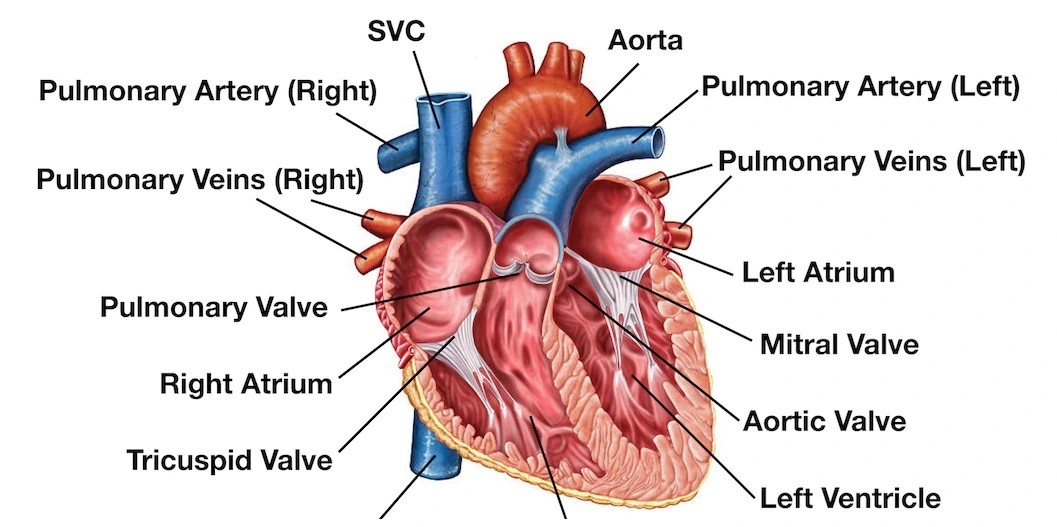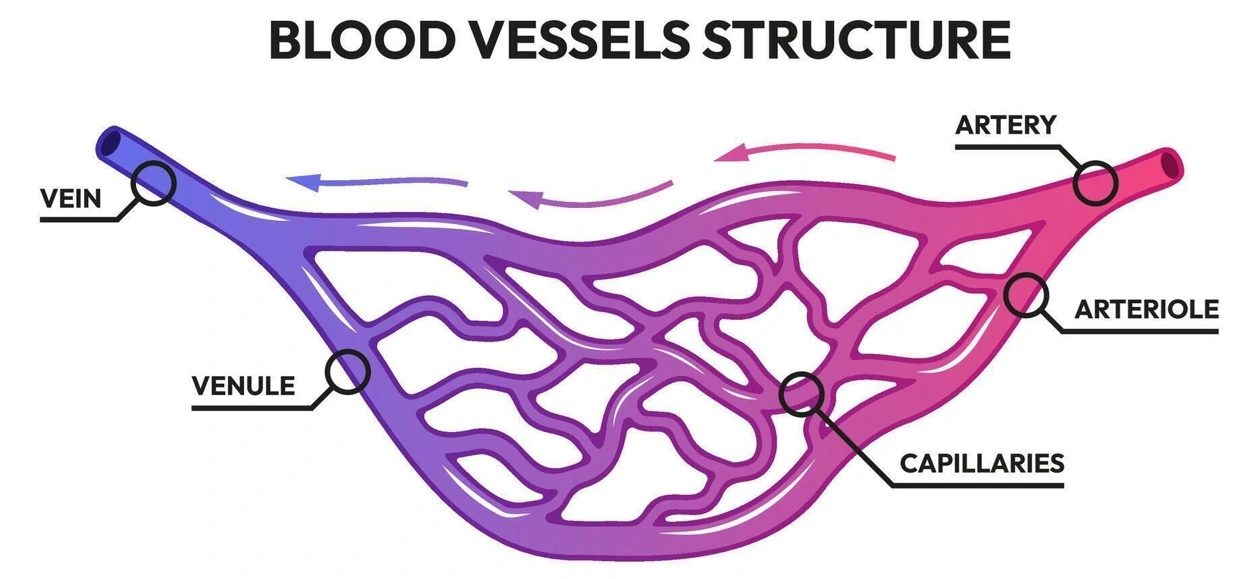Cardiovascular System
The Cardiovascular System, also known as the circulatory system, is a vibrant network in the human body responsible for transporting blood, oxygen, nutrients, and waste products. It comprises of the heart, blood vessels, and blood, working together to keep homeostasis. The Cardiovascular System is formed by the blood vessels and the heart.
The heart assists as the system’s pump, propelling blood through arteries, veins, and capillaries. Arteries carry oxygen-rich blood away from the heart to tissues, while veins return oxygen-depleted blood back to the heart. Capillaries facilitate the exchange of oxygen, nutrients, and waste at the cellular level. This system plays a crucial role in maintaining the body’s internal environment, regulating temperature, and supporting immune responses. Understanding the cardiovascular system is fundamental to biology, offering insights into how the body sustains life and adapts to physical demands.
Blood Vessels
Blood vessels are a huge network of tubes through which blood circulates, distributed throughout the body. There are three types of blood vessels: arteries, veins and capillaries.
Blood Vessels are an essential part of the cardiovascular system, functioning as the body’s network for transporting blood. They come in three main types: arteries, veins, and capillaries. Arteries carry oxygen-rich blood away from the heart to the body’s tissues, and they have thick, elastic walls to handle high pressure. Veins return oxygen-depleted blood back to the heart, equipped with valves to prevent backflow as blood moves under lower pressure. Capillaries are the smallest blood vessels, forming a dense network that allows for the exchange of oxygen, nutrients, carbon dioxide, and waste between blood and tissues. This intricate system of blood vessels ensures that every cell in the body receives the resources it needs while removing waste products, playing a critical role in maintaining overall health and homeostasis.
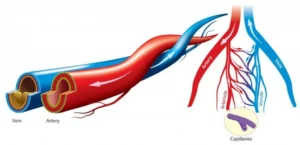 Arteries are vessels of the cardiovascular system, through which blood passes from the heart and is transported to other parts of the body. They have thick, elastic walls composed of three layers: the innermost endothelium, the middle smooth muscle layer, and the outer connective tissue layer. This structure allows arteries to withstand and regulate the high pressure generated by the heart’s pumping action. Major arteries branch into smaller arterioles, eventually connecting to capillaries where nutrient and gas exchange occurs. Key arteries like the aorta and coronary arteries play vital roles in maintaining circulation and supplying the heart muscle itself. The health of arteries is crucial, as conditions like atherosclerosis (plaque buildup) can impede blood flow and lead to serious issues such as heart attacks or strokes.
Arteries are vessels of the cardiovascular system, through which blood passes from the heart and is transported to other parts of the body. They have thick, elastic walls composed of three layers: the innermost endothelium, the middle smooth muscle layer, and the outer connective tissue layer. This structure allows arteries to withstand and regulate the high pressure generated by the heart’s pumping action. Major arteries branch into smaller arterioles, eventually connecting to capillaries where nutrient and gas exchange occurs. Key arteries like the aorta and coronary arteries play vital roles in maintaining circulation and supplying the heart muscle itself. The health of arteries is crucial, as conditions like atherosclerosis (plaque buildup) can impede blood flow and lead to serious issues such as heart attacks or strokes.
The arteries branch out and decrease in diameter, which in turn flow into even thinner vessels, the capillaries .
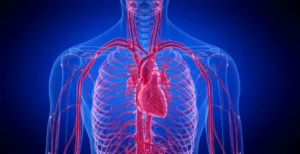 Veins are vessels of the cardiovascular system that transport blood from different parts of the body back to the heart. Their walls are thinner than those of arteries and, therefore, the transport of blood is slower.
Veins are vessels of the cardiovascular system that transport blood from different parts of the body back to the heart. Their walls are thinner than those of arteries and, therefore, the transport of blood is slower.
Therefore, the blood pressure inside the veins is low, which makes it difficult for it to return to the heart. The existence of valves in these vessels means that the blood always moves towards the heart.
It is important to highlight that most veins (jugular, saphenous, cerebral and several others) carry blood rich in carbon dioxide. The pulmonary veins carry blood rich in oxygen from the lungs to the heart.
Veins play a crucial role in the circulatory system by collecting waste-laden blood from capillaries and delivering it back to the heart for re-oxygenation. Key veins include the vena cava (superior and inferior), which return blood to the heart from the upper and lower body, respectively. Maintaining healthy veins is essential, as issues like varicose veins or deep vein thrombosis (DVT) can disrupt circulation and lead to complications.
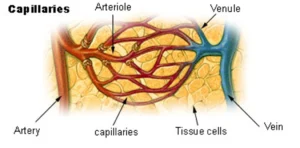 Capillaries are microscopic branches of arteries and veins, which enable the formation of a communication network between large vessels.
Capillaries are microscopic branches of arteries and veins, which enable the formation of a communication network between large vessels.
Its walls are made up of a very thin layer of cells that allows the exchange of substances between the blood and the cells and vice versa. The substances that are exchanged are: oxygen, carbon dioxide, nutrients, among others.
Heart
The heart is an organ of the cardiovascular system located in the rib cage, between the lungs. Its function is to pump blood through the blood vessels to irrigate the entire body.
It is hollow and muscular, surrounded by a membrane called the pericardium , and internally the heart cavities are lined by a membrane called the endocardium . Its walls are made up of a muscle, the myocardium , which is responsible for the heart’s contractions.
The myocardium has four internal cavities : two upper cavities called atria (right and left) and two lower cavities called ventricles (right and left). The ventricles have thicker walls than the atria.
The right atrium communicates with the right ventricle and the same happens on the left side. However, there is no communication between the two atria, nor between the two ventricles.
Valves are used to prevent the backflow of blood from the ventricles to the atria. The tricuspid valve is between the right atrium and the right ventricle , and the mitral or bicuspid valve is between the left atrium and the left ventricle .
The heart has two primary functions: pumping oxygen-depleted blood to the lungs for oxygenation through the pulmonary circulation and distributing oxygen-rich blood to the rest of the body via the systemic circulation. The cardiac cycle involves rhythmic contractions (systole) and relaxations (diastole), regulated by an electrical conduction system originating in the sinoatrial (SA) node, the natural pacemaker.
Composed of specialized cardiac muscle, the heart requires a continuous supply of oxygen and nutrients, which is delivered by the coronary arteries. A healthy heart is vital for sustaining life, as it ensures that all tissues receive the oxygen and nutrients they need while removing carbon dioxide and other waste products. Understanding the heart is fundamental to biology and medicine, as conditions such as heart attacks, arrhythmias, and heart failure can have significant health impacts.
Pulsation
The pulse of the cardiovascular system is observed each time the ventricles contract, pushing blood into the arteries, or with each heartbeat.
Through this pulsation movement, also called arterial pulse , it is possible to check the frequency of the heartbeat.
It is important to highlight that the heart is an organ that works at a constant rhythm. Irregularities in its rhythm indicate poor heart function, characterized by cardiac arrhythmias.
Arrhythmias can manifest with palpitations, breathing difficulties, chest pain, dizziness and fainting.
In a healthy individual, the pulse is typically steady and regular, but variations in pulse can indicate underlying medical conditions such as arrhythmias, hypotension, or blockages in the arteries.
Cardiovascular System Download in PDF
